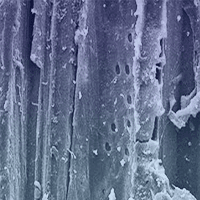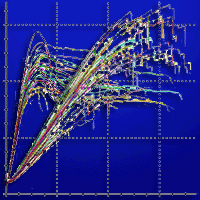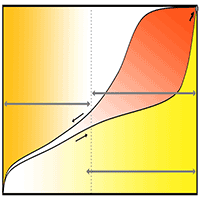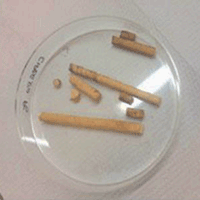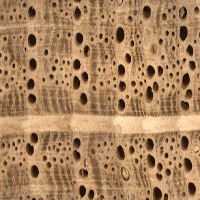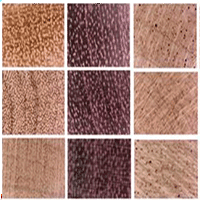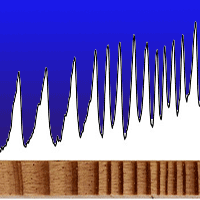The relationship between the mechanical properties of Cunninghamia lanceolata (Chinese fir) wood and the development of fungal decay was investigated with the aim of implementing a statistical model useful as a non-destructive and a fast method for determining the state of conservation of in-service timber structures. Artificial decay due to brown rot fungi was induced on wood specimens and physical and mechanical test were performed periodically, as well as anatomical observation of wood, FT-IR spectroscopic and XRD diffraction analysis. As a result, Chinese fir was confirmed to have a good durability against fungi, showing a mass loss percentage of 7.21% on average after 14 weeks of exposure. On the contrary, the mechanical properties reduced dramatically during the decay test: a 19% decrease was observed for compression strength and 21% for tensile strength. The mechanism of decay was explored and the corresponding damage constitutive model was proposed.
Keywords
, , , ,
Citation
Li S, Gao Y, Brunetti M, Macchioni N, Nocetti M, Palanti S (2019). Mechanical and physical properties of Cunninghamia lanceolata wood decayed by brown rot. iForest 12: 317-322. - doi: 10.3832/ifor2922-012
Academic Editor
Rodolfo Picchio
Paper history
Received: Jul 18, 2018
Accepted: Apr 03, 2019
First online: Jun 06, 2019
Publication Date: Jun 30, 2019
Publication Time: 2.13 months
© SISEF - The Italian Society of Silviculture and Forest Ecology 2019
Open Access
This article is distributed under the terms of the Creative Commons Attribution-Non Commercial 4.0 International (https://creativecommons.org/licenses/by-nc/4.0/), which permits unrestricted use, distribution, and reproduction in any medium, provided you give appropriate credit to the original author(s) and the source, provide a link to the Creative Commons license, and indicate if changes were made.

Breakdown by View Type
(Waiting for server response...)
Article Usage
Total Article Views: 47112
(from publication date up to now)
Breakdown by View Type
HTML Page Views: 39202
Abstract Page Views: 3778
PDF Downloads: 3313
Citation/Reference Downloads: 0
XML Downloads: 819
Web Metrics
Days since publication: 2400
Overall contacts: 47112
Avg. contacts per week: 137.41
Article Citations
Article citations are based on data periodically collected from the Clarivate Web of Science web site
(last update: Mar 2025)
Total number of cites (since 2019): 12
Average cites per year: 1.71
Publication Metrics
by Dimensions ©
Articles citing this article
List of the papers citing this article based on CrossRef Cited-by.
(1)
Chen X (2011)The influence of incipient brown rot on the properties of Chinese fir at macroscopic and tissue level. Chinese Academy of Forestry Sciences, China, pp. 75-79. [in Chinese]
Online |
Gscholar
(2)
Chen M, Wang C, Fei B, Ma X, Zhang B, Zhang S, Huang A (2017)Biological degradation of Chinese fir with
Trametes versicolor (L.) Lloyd. Materials 10 (7): 834.
CrossRef |
Gscholar
(3)
Cowling E (1961)Comparative biochemistry of the decay of sweetgum sapwood by white-rot and brown-rot fungi. USDA Technical Bulletin, vol. 1258, pp. 63-74.
Online |
Gscholar
(4)
Curling S, Clausen C, Winandy J (2002)Relationships between mechanical properties, weight loss, and chemical composition of wood during incipient brown-rot decay. Forest Products Journal 52 (7): 34-37.
Online |
Gscholar
(5)
Durmaz S, Ozgenç O, Boyaci IH, Yildiz UC, Erisir E (2016)Examination of the chemical changes in spruce wood degraded by brown-rot fungi using FT-IR and FT-Raman spectroscopy. Vibrational Spectroscopy 85: 202-207.
CrossRef |
Gscholar
(6)
Eaton RA, Hale MDC (1993)Wood: decay, pests and protection. Chapman and Hall, London, UK, pp. 546.
Online |
Gscholar
(7)
Fackler K, Stevanic JS, Ters T, Hinterstoisser B, Schwanninger M, Salmén L (2010)Localisation and characterisation of incipient brown-rot decay within spruce wood cell walls using FT-IR imaging microscopy. Enzyme and Microbial Technology 47 (6): 257-267.
CrossRef |
Gscholar
(8)
Faix O, Bremer O, Schmidt O, Stevanovic T (1991)Monitoring of chemical changes in white-rot degraded beech wood by pyrolysis-gas chromatography and Fourier transform infrared spectroscopy. Journal of Analytical and Applied Pyrolysis 21: 147-62.
CrossRef |
Gscholar
(9)
Kleindienst Q, Besserer A, Antoine M, Perrin C, Bocquet J, Bléron L (2017)Predicting the beech wood decay and strength loss in-ground. International Biodeterioration and Biodegradation 123: 96-105.
CrossRef |
Gscholar
(10)
Li P (2009)Mechanical mechanism of beam-column joints in wooden frame of Tibetan ancient architecture. PhD thesis, Civil Engineering School, Beijing Jiaotong University, China, pp. 25-32. [In Chinese]
Online |
Gscholar
(11)
Lin J, Zhao G, Zhang W (2009)Microstructure and stress relaxation of the decayed wood by fungi. Journal of Beijing Forestry University 31 (s1): 62-66. [In Chinese]
Online |
Gscholar
(12)
Lu X, Wang D, Zhou M (1987)Influence of the extractives of Chinese fir wood upon their natural resistance to fungus and termite damage. Scientia Silvae Sinicae 23 (4): 456-462.
Online |
Gscholar
(13)
Ma X, Kirker G, Clausen C, Jiang M, Zhou H (2017)Modulus of elasticity loss as a rapid indicator of rot-fungal attack on untreated and preservative-treated wood in laboratory tests. BioRescourse 12 (1): 1850-1860.
CrossRef |
Gscholar
(14)
Maréchal Y, Chanzy H (2000)The hydrogen bond network in I_ cellulose as observed by infrared spectrometry. Journal of Molecular Structure 523: 183-96.
CrossRef |
Gscholar
(15)
NTC-TSA (2009a)Method of sample tree collection for physical and mechanical tests of wood (GB/T1927-2009). National Technical Committee on Timber of Standardization Administrator of China (NTC-TSA), Standards Press of China, Beijing, China, pp. 3-7. [In Chinese].
Online |
Gscholar
(16)
NTC-TSA (2009b)Method of sample logs sawing test specimen selection for physical and mechanical tests of wood (GB/T1929-2009). National Technical Committee on Timber of Standardization Administrator of China (NTC-TSA), Standards Press of China, Beijing, China, pp. 3-7. [In Chinese]
Online |
Gscholar
(17)
NTC-TSA (2009c)Method for laboratory test of natural decay resistance of woods (GB/T1394 2:1-92). National Technical Committee on Timber of Standardization Administrator of China (NTC-TSA), Standards Press of China, Beijing, China, pp. 3-6. [In Chinese]
Online |
Gscholar
(18)
Pizzo B, Pecoraro E, Alves A, Macchioni N, Rodrigues JC (2015)Quantitative evaluation by attenuated total reflectance infrared (ATR-FTIR) spectroscopy of the chemical composition of decayed wood preserved in waterlogged conditions. Talanta 131: 14-20.
CrossRef |
Gscholar
(19)
Pizzo B, Macchioni N, Capretti C, Pecoraro E, Sozzi L, Fiorentino L (2016)Assessing the wood compressive strength in pile foundations in relation to diagnostic analysis: the example of the church of Santa Maria Maggiore, Venice. Construction and Building Materials 114: 470-480.
CrossRef |
Gscholar
(20)
Que Z, Li Z, Zhang X, Yuan Z, Pan B (2017)Wood in civil engineering: traditional wooden buildings in China. InTech Open, London, UK, pp. 204.
CrossRef |
Gscholar
(21)
Tagarielli V, Deshpande V, Fleck N, Chen C (2005)A constitutive model for transversely isotropic foams, and its application to the indentation of balsa wood. International Journal of Mechanical Sciences 47 (4-5): 666-686.
CrossRef |
Gscholar
(22)
Teodorescu I, Tapusii D, Erbasu R, Bastidas-Arteaga E, Aoues Y (2016)Influence of the climatic changes on wood structures behaviour. Energy Procedia 112 (112): 450-459.
CrossRef |
Gscholar
(23)
Wang J (2015)Analysis of the structural performance of two and six level wooden model. Taiyuan University of Technology, China, pp. 40-41. [in Chinese]
Online |
Gscholar
(24)
Wilcox W (1978)Review of literature on the effects of early stages of decay on wood strength. Wood and Fiber 9 (4): 252-257.
Online |
Gscholar
(25)
Winandy J, Morrell J (1993)Relationship between incipient decay, strength, and chemical composition of Douglas-Fir heartwood. Wood and Fiber Science 25 (3): 278-288.
Online |
Gscholar
(26)
Witomski P, Olek W, Bonarski J (2016)Changes in strength of scots pine wood (
Pinus silvestris L.) decayed by brown rot (
Coniophora puteana) and white rot (
Trametes versicolor). Construction and Building Materials 102: 162-166.
CrossRef |
Gscholar
(27)
Yokoyama M, Gril J, Matsuo M, Yano H, Sugiyama J, Clair B, Kubodera S, Mistutani T, Sakamoto M, Ozaki H, Imamura M, Kawai S (2009)Mechanical characteristics of aged Hinoki wood from Japanese historical buildings. Comptes Rendus Physique 10 (7): 601-611.
CrossRef |
Gscholar
